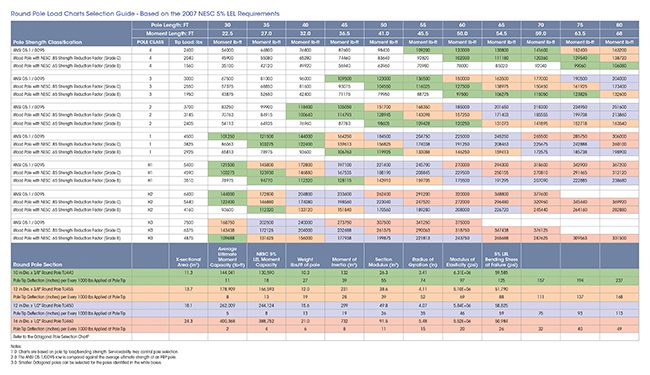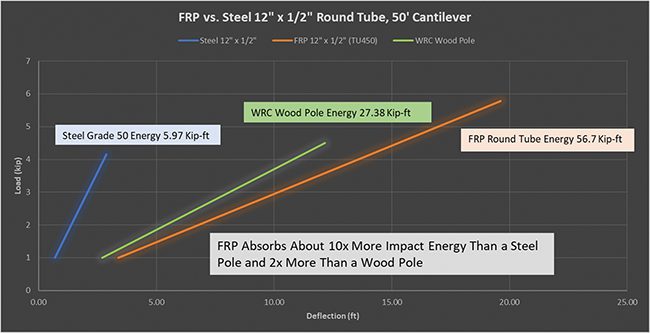The Benefits of Fiber-Reinforced Polymer in Power Transmission
Wood, steel, and concrete are commonly used materials for power poles. However, fiber-reinforced polymer (FRP) offers a relatively lightweight, safe, and resilient alternative, which also offers a long service life.
As humans try to move toward “greener” pastures to combat climate change, our power grid is under immense strain. The U.S. grid got its last major overhaul more than 70 years ago, and these now-ancient poles and lines simply cannot step up to the challenge of increasing electrification. A boom in electric vehicles and a surge in 5G build-out ask more of our power infrastructure and utility poles than they can handle, even without the destruction of an increasing number of severe weather events.
Beyond ever-present shortages of funding and labor, grid modernization must face nature’s supply chain problem: trees for high-strength poles. Let’s look at what’s happening with wood first. Then, let’s consider how, as power professionals, we’ve got to expand our toolbox to include composites.
More, Stronger Poles Needed
The modern power grid has to factor in greater live and dead loads that can support our electrification plans and can survive more-severe thunderstorms, hurricanes, wildfires, and more. This means not just more poles but stronger ones.
Table 1 shows the American National Standards Institute’s (ANSI’s) pole class ratings and their traditional suitability. Pole materials are more varied now, but ANSI ratings are based on wood, the only available material for poles originally. But the realities behind this chart are changing.
 |
|
Table 1. The data in this table is taken from the National Wood Pole Standards. Source: Nelson Research |
Storms especially have gotten meaner. They hit our power grid with more intensity than traditional Class 5 or 6 poles can handle. The answer has been either to increase the number of lower-class poles or to upgrade to higher-class ones. Even distribution poles can sometimes approach Class 1 or H-class, and transmission poles have mostly moved into the H-classes from Class 1, 2, or 3.
Because of this move to higher classes, a second problem emerges: wood supply. Wood utility poles can come from only certain tree types and heights. Suitable trees make up less than 10% of the average forest. A single tree needs more than a quarter century to grow to usable size, and even then, some will be disqualified for utility use due to size or qualities. And this doesn’t even consider the demand for high-strength, long-length poles for non-utility industries.
This is why, especially for transmission, utilities have largely transitioned to steel. The American Iron and Steel Institute’s 2013 life cycle assessment (LCA) study stood steel and wood up against each other and found steel often outperforms wood on durability and environmental impact. Other utilities have looked to concrete for a solution.
The massive overhaul our grid needs requires that we arm ourselves with as many tools as possible to meet the demand for stronger, safer, more sustainable utility poles. Fiber-reinforced polymer (FRP), a composite, is another available option that is up to the challenge of even power transmission.
FRP Utility Poles: How Do They Compare?
An engineered material consisting of reinforcement fibers, polymer resin, and additives, FRP is both strong and durable. FRP utility poles are pultruded, which yields a constant cross-section, fiber tension, and orientation. The selection guide (Figure 1) shows the equivalent Creative Composites Group FRP poles for different classes and lengths of wood poles.
 |
|
1. To use the chart, locate the desired wood strength classification, class, and length. The color of the box corresponds to the equivalent fiber-reinforced polymer (FRP) pole. For example, if you required a 70-foot Class H2 ANSI 05.1/GO95 pole, the red box indicates the 16-inch diameter TU460 pole as the equivalent. Creative Composites Group is constantly expanding its offerings to meet market needs, which is why an 18-inch pole will soon be available. Courtesy: Creative Composites Group (CCG) |
A 40-foot Class 1 wood pole weighs about 1,100 pounds and a similar steel pole weighs 692 pounds. However, an equivalent FRP pole is much lighter than either of those options, weighing 412 pounds. This light weight makes FRP poles a great choice for limited-access areas or for helicopter sets, as more can be transported to the site in fewer loads without sacrificing strength.
Comparing its strength to its weight, FRP has a much greater ratio. As shown in Table 2, the stiffness-to-weight ratio for glass FRP ranks lower than steel, but this can be overcome with cross-section geometry. Other qualities that make FRP poles good for both transmission and distribution are their safety characteristics, resiliency, and long service life.
 |
|
Table 2. This table shows some properties of different types of poles. The information for Glass FRP and Carbon FRP is conservative; the actual material properties of FRP are usually higher. Source: CCG |
Safety. Line crew demonstrations have proven that composite poles are light enough to be moved along the ground by a single person and that these poles are field-drillable, unlike concrete and steel. FRP poles aren’t treated with pesticides or chemicals and don’t leach anything harmful into the ground.
Further keeping workers and the grid safe, FRP poles overcome a major drawback of steel poles: conductivity and low dielectric strength. Steel poles offer excellent strength, stiffness, and length of service life, but as a metal, they must be properly insulated to prevent hazards and interruptions or to avoid breakdown from contact with high voltages. FRP has low thermal conductivity and great dielectric strength.
Resiliency. Composite poles are pultruded, meaning the profile is pulled through and exits the die in the desired cross-section or shape. As an engineered material, composite utility poles exhibit a coefficient of variation of less than 5%. Pultruded profiles have a higher tensile strength than conventional steel, and are designed to be somewhat flexible so they can endure a significant load during extreme conditions and yet return to their initial state. This is a significant benefit when compared to steel, which stays bent if stressed past its yield strength, or to wood and concrete, which can snap.
FRP’s impact energy absorption capacity is also the highest among competing materials. As the graph in Figure 2 shows, FRP poles can take on twice the impact energy of wood and, especially important to transmission design engineers, 10 times more than steel. FRP poles also have a good modulus of elasticity and good flexural strength.
 |
|
2. This chart compares the impact energy that steel, wood, and FRP poles can withstand. Courtesy: CCG |
Service Life. FRP poles are capable of long service lives. FRP is inherently corrosion-resistant because no component of the composite can oxidize. This also makes it inert to a wide variety of bases and acids. And unlike wood and concrete, FRP absorbs a negligible amount of moisture, and it is not susceptible to moisture exposure degradation like steel. Furthermore, composites are unattractive to termites, woodpeckers, squirrels, beavers, and other wildlife that can damage wood poles. To add ultraviolet (UV) protection, FRP receives a nontoxic coating, and for aesthetic or architectural benefits, composite utility poles can be tinted to customer color specifications to better blend in with their surroundings.
Expand the Options for Transmission
Utilities need to consider every available option for power poles as the time—and finally the funding—becomes available to revitalize our decrepit grid. When specifying utility poles, consider composite poles alongside traditional alternatives. The data show that FRP poles have the performance and mechanical characteristics to harden the modern power grid. Composites and their many benefits may be just what your project is looking for.
Creative Composites Group (CCG) is just one manufacturer of pultruded FRP utility poles. The following link will open a large chart titled “StormStrong Round Pole Mechanical and Physical Properties,” which shares data for the four round FRP poles currently offered by CCG.
—Dustin Troutman is corporate director of Marketing and Product Development with Creative Pultrusions Inc., a CCG company.